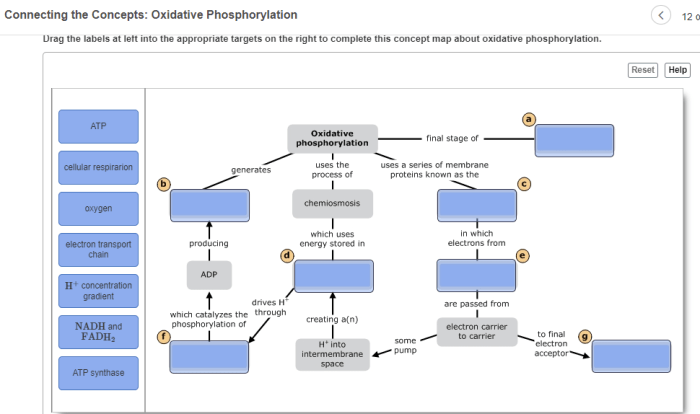Concept map of oxidative phosphorylation, a fundamental process in cellular respiration, unveils the intricate mechanisms of energy production within living cells. This detailed guide explores the components, mechanisms, and clinical significance of oxidative phosphorylation, providing a comprehensive understanding of this vital cellular process.
Oxidative phosphorylation is a multi-step process that generates ATP, the primary energy currency of cells. It involves the electron transport chain, chemiosmosis, and ATP synthase. Defects in these components can lead to various diseases, highlighting the clinical importance of oxidative phosphorylation.
1. Introduction

Oxidative phosphorylation is a vital process in cellular respiration that generates the majority of the cell’s ATP. It occurs in the inner mitochondrial membrane and involves the transfer of electrons through a series of protein complexes known as the electron transport chain (ETC).
The concept map of oxidative phosphorylation provides a visual representation of the components and processes involved in this complex pathway.
2. Components of the Electron Transport Chain: Concept Map Of Oxidative Phosphorylation

The ETC consists of four protein complexes (I-IV) and two mobile electron carriers, ubiquinone and cytochrome c.
- Complex I (NADH-ubiquinone oxidoreductase): Receives electrons from NADH and passes them to ubiquinone.
- Complex II (succinate-ubiquinone oxidoreductase): Receives electrons from succinate and passes them to ubiquinone.
- Complex III (ubiquinone-cytochrome c oxidoreductase): Receives electrons from ubiquinone and passes them to cytochrome c.
- Complex IV (cytochrome c oxidase): Receives electrons from cytochrome c and combines them with oxygen to form water.
3. Chemiosmosis and ATP Synthesis

The movement of electrons through the ETC creates an electrochemical gradient across the inner mitochondrial membrane. This gradient drives the process of chemiosmosis, which involves the flow of protons across the membrane.
The protons are pumped into the intermembrane space by Complexes I, III, and IV. The proton gradient then drives the synthesis of ATP by ATP synthase, a protein complex that spans the inner mitochondrial membrane.
4. Regulation of Oxidative Phosphorylation

The rate of oxidative phosphorylation is regulated by several factors, including:
- ADP/ATP ratio: High ADP levels stimulate oxidative phosphorylation, while high ATP levels inhibit it.
- Phosphorylation of Complex I: Phosphorylation by protein kinase A (PKA) inhibits Complex I activity.
- Substrate availability: The availability of NADH and FADH2 (electron donors) affects the rate of oxidative phosphorylation.
5. Clinical Significance
Defects in the ETC or ATP synthase can lead to a variety of diseases, including:
- Mitochondrial encephalomyopathy, lactic acidosis, and stroke-like episodes (MELAS): Caused by mutations in mitochondrial DNA.
- Leigh syndrome: A fatal neurodegenerative disorder caused by mutations in nuclear genes encoding ETC components.
- Cytochrome c oxidase deficiency: A rare disorder that can lead to cardiomyopathy and encephalopathy.
6. Future Directions
Current research directions in oxidative phosphorylation include:
- Targeting oxidative phosphorylation for therapeutic applications: Developing drugs that modulate oxidative phosphorylation to treat diseases such as cancer and neurodegenerative disorders.
- Understanding the role of oxidative phosphorylation in aging: Investigating the relationship between oxidative phosphorylation and age-related decline in cellular function.
Clarifying Questions
What is oxidative phosphorylation?
Oxidative phosphorylation is a process that uses the energy released from the oxidation of nutrients to synthesize ATP, the energy currency of cells.
What are the components of the electron transport chain?
The electron transport chain consists of four protein complexes (I-IV), ubiquinone, and cytochrome c, which facilitate the transfer of electrons and protons.
How does chemiosmosis contribute to ATP synthesis?
Chemiosmosis is the process by which the electrochemical gradient generated by the electron transport chain drives the synthesis of ATP by ATP synthase.